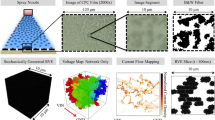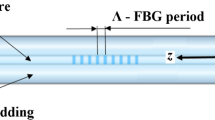Abstract
This work is concerned with two important scientific areas: mechanics of polymer composite materials (PCMs) and the development of new methods for diagnostics and monitoring of the mechanical state of a structure based on fiber-optic sensors. The nomenclature and the range of application of PCMs are expanding very rapidly. Currently, the percentage of the use of composite materials is one of the indicators of the competitiveness of the corresponding products. At the same time, theoretical results concerning the assessment of the workability of PCM structures do not always keep up with the requests of designers developing new products. Therefore, model assessments should be complemented with modern monitoring systems. Fiber-optic sensors offer opportunities for creating new monitoring scenarios. One of them is associated with the use of sensors embedded in a PCM. This gives a new kind of smart material, in which the PCM, along with its basic functions, provides information on its parameters: temperature, strain, etc. The development of this class of smart materials requires solving a number of problems. One of them, which is the subject of the present work, is the evaluation by methods of mathematical modeling of changes in the stiffness and strength characteristics of PCM products due to the integration of fiber-optical sensors into the material. In contrast to the known works, the developed computational models take into account the layered structure of a PCM, the types of layer stacking, the arrangement of layers and optical fiber, the presence of a technological defect in the form of a resin pocket with the elimination of points of stress singularity that are present in the known computational schemes. The model proposed in this work can be used to estimate the stress concentration in the layers of the composite material adjacent to the optical fiber.
Similar content being viewed by others
References
Kelly, A., Concise Encyclopedia of Composite Materials, Cambridge: Elsevier, 1994.
Council, N.R., New Materials for Next-Generation Commercial Transports, Washington, DC: The National Academies Press, 1996.
Cai, J., Qiu, L., Yuan, S., Shi, L., Liu, P., and Liang, D., Structural health monitoring for composite materials, in Composites and Their Applications, Rijeka, Croatia: InTech, 2012, pp. 37–60. https://doi.org/10.5772/4821510.5772/48215
Gebremichael, Y., Li, W., Boyle, W.J.O., Meggitt, B.T., Grattan, K.T.V., McKinley, B., Fernando, G.F., Kister, G., Winter, D., Canning, L., and Luke, S., Integration and assessment of fibre Bragg grating sensors in an all-fibre reinforced polymer composite road bridge, Sens. Actuators, A, 2005, vol. 118, no. 1, pp. 78–85. https://doi.org/10.1016/j.sna.2004.08.005
Lee, J.-R., Ryu, C.-Y., Koo, B.-Y., Kang, S.-G., Hong, C.-S., and Kim, C.-G., In-flight health monitoring of a subscale wing using a fiber Bragg grating sensor system, Smart Mater. Struct., 2003, vol. 12, pp. 147–155. https://doi.org/10.1088/0964-1726/12/1/317
Ghoshal, A., Ayers, J., Gurvich, M., Urban, M., and Bordick, N., Experimental investigations in embedded sensing of composite components in aerospace vehicles, Composites, Part B, 2015, vol. 71, pp. 52–62. https://doi.org/10.1016/j.compositesb.2014.10.050
Wymore, M.L., Van Dam, J.E., Ceylan, H., and Qiao, D., A survey of health monitoring systems for wind turbines, Renewable Sustainable Energy Rev., 2015, vol. 52, no. 1069283, pp. 976–990. https://doi.org/10.1016/j.rser.2015.07.110
Sierra-Pérez, J., Torres-Arredondo, M.A., and Güemes, A., Damage and nonlinearities detection in wind turbine blades based on strain field pattern recognition. FBGs, OBR and strain gauges comparison, Compos. Struct., 2016, vol. 135, pp. 156–166. https://doi.org/10.1016/j.compstruct.2015.08.137
Hong, C.Y., Zhang, Y.F., Zhang, M.X., Leung, L.M.G., and Liu, L.Q., Application of FBG sensors for geotechnical health monitoring, a review of sensor design, implementation methods and packaging techniques, Sens. Actuators, A, 2016, vol. 244, pp. 184–197. https://doi.org/10.1016/j.sna.2016.04.033
Takeda, N., in Proceedings of the 26th International Congress on Aeronautics Science, Anchorage, Alaska, USA, September 14–19, 2008, p. 12. https://doi.org/www.iccm-central.org/Proceedings/ICCM17proceedings/Themes/Plenaries/P1.15%20Takeda.pdf
Kablov, E.N., Sivakov, D.V., Gulyaev, I.N., Sorokin, K.V., Fedotov, M.Yu., and Dianov, E.M., Application of optical fiber as strain gauges in polymer composite materials, Polym. Sci., Ser. D., 2011, vol. 4, no. 3, ppl 246–251. https://doi.org/10.1134/S1995421211030063
Li, X.X., Ren, W.X., and Bi, K.M., FBG force-testing ring for bridge cable force monitoring and temperature compensation, Sens. Actuators, A, 2015, vol. 223, pp. 105–113. https://doi.org/10.1016/j.sna.2015.01.003
García, I., Zubia, J., Durana, G., Aldabaldetreku, G., Illarramendi, M.A., and Villatoro, J., Optical fiber sensors for aircraft structural health monitoring, Sensors, 2015, vol. 15, no. 7, pp. 15949–15519. https://doi.org/10.3390/s150715494
Balać, I. and Milovančević, M., Stress field analysis around optical fiber embedded in composite laminae under transverse loading, FME Trans., 2006, vol. 34, no. 1, pp. 53–56. https://doi.org/www.mas.bg.ac.rs/_media/istrazivanje/fme/vol34/1/8._balac_igor.pdf
Luyckx, G., Voet, E., DeWaele, W., and Degrieck, J., Multi-axial strain transfer from laminated CFRP composites to embedded Bragg sensor: I. Parametric study, Smart Mater. Struct., 2010, vol. 19, no. 10, pp. 1–9. https://doi.org/10.1088/0964-1726/19/10/105017
Maksidov, V., Fedotov, M., Shienok, A., and Zuev, M., For an issue of embedded optical fibre in CFRP and strain measurement with fibre Bragg gratings sensors, Mekh. Kompoz. Mater. Konstrukts., 2014, vol. 20, no. 4, pp. 568–574.
Di Sante, R., Fibre optic sensors for structural health monitoring of aircraft composite structures: recent advances and applications, Sensors, 2015, vol. 15, no. 8, pp. 18666–18713. https://doi.org/10.3390/s150818666
Majumder, M., Gangopadhyay, T.K., Chakraborty, A.K., Dasgupta, K., and Bhattacharya, D.K., Fibre Bragg gratings in structural health monitoring-Present status and applications, Sens. Actuators, A, 2008, vol. 147, no. 1, pp. 150–164. https://doi.org/10.1016/j.sna.2008.04.008
Kablov, E., Sivakov, D., Gulyaev, I., Sorokin, K., Fedotov, M., Dianov, E., Vasil’ev, S., and Medvedkov, O., Application of optical fiber as strain sensors in polymer composite materials, Vse Mater. Entsikl. Spravochnik, 2010, no. 3, pp. 10–15.
Lammens, N., Luyckx, G., Van Paepegem, W., and Degrieck, J., Finite element prediction of resin pocket geometries around arbitrary inclusions in composites: case study for an embedded optical fiber interrogator, Compos. Struct., 2016, vol. 146, pp. 95–107. https://doi.org/10.1016/j.compstruct.2016.03.001
Bhargava, A., Shivakumar, K., and Emmanwori, L., in Proceedings of the AIAA/ASME/ASCE/AHS/ASC Structures, Structural Dynamics and Materials Conference, Norfolk, Virginia, USA, April 7–10, 2003, vol. 6, pp. 4128–4140.
Shivakumar, K. and Bhargava, A., Failure mechanics of a composite laminate embedded with a fiber optic sensor, J. Compos. Mater., 2005, vol. 39, no. 9, pp. 777–798. https://doi.org/10.1177/0021998305048156
Shivakumar, K. and Emmanwori, L., Mechanics of failure of composite laminates with an embedded fiber optic sensor, J. Compos. Mater., 2004, vol. 38, no. 8, pp. 669–680. https://doi.org/10.1177/0021998304042393
Korepanov, V.V., Serovaev, G.S., and Yurlova, N.A., Numerical modelling of layered composite materials with embedded optical fiber sensors, Solid State Phenom., 2015, vol. 243, pp. 83–88. https://doi.org/10.4028/www.scientific.net/SSP.243.83
Banea, M.D. and Da Silva, L.F.M., Adhesively bonded joints in composite materials: an overview, Proc. Inst. Mech. Eng., Part L: J. Mater. Des. Appl., 2009, vol. 223, no. 1, pp. 1–18. https://doi.org/10.1243/14644207JMDA219
Author information
Authors and Affiliations
Corresponding author
Additional information
Original Russian Text © N.A. Kosheleva, G.S. Serovaev, 2018, published in Vychislitel’naya Mekhanika Sploshnykh Sred, 2017, Vol. 10, No. 4, pp. 466–473.
Rights and permissions
About this article
Cite this article
Kosheleva, N.A., Serovaev, G.S. Modeling a Stressed State in the Vicinity of an Optical Fiber Embedded in a Polymer Composite Material with Allowance for the Structural Features of the Composite. J Appl Mech Tech Phy 59, 1271–1278 (2018). https://doi.org/10.1134/S0021894418070088
Received:
Accepted:
Published:
Issue Date:
DOI: https://doi.org/10.1134/S0021894418070088




